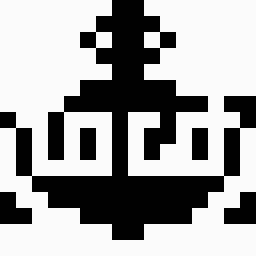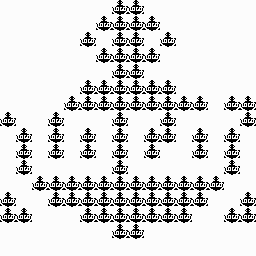![]() The Screen Robot = NAKI
The Screen Robot = NAKI
![]() Block-Recursive Naki
Block-Recursive Naki
OZ-LOGO is the generic name of a "Tiny"version of LOGO I implemented for the Australian 8-bit microcomputer the MicroBee in 1983. (The microBee was based on the Z-80 8-bit microprocessor). OZ-LOGO was marketed by Applied Technology on a 2K ROM.

The OZ-LOGO Screen Robot (NAKI).
 The OZ-LOGO Screen Robot (NAKI) moved about a tiled region on the screens. The tiles were the same size as the naki itself,
The OZ-LOGO Screen Robot (NAKI) moved about a tiled region on the screens. The tiles were the same size as the naki itself,
 and there were 16x16 of the tiles in the naki territory (for the basic mode). The naki had just four possible headings, North (upscreen)
and there were 16x16 of the tiles in the naki territory (for the basic mode). The naki had just four possible headings, North (upscreen)  , South
, South  , East
, East  and West
and West  .
.
As in traditional line-oriented logo - the NAKI could leave a trail - as it moved from tile to tile. The trail was made up of dump tiles.
The dump tiles used for trail-marking were created as the thumb image of the naki territory, if a cell in the territory was marked, then the corresponding pixel in the thumb was set. Of course, a tile could be exploded to full-size, using either a standard black tile, or the current dump character.


THE EXPLODED NAKI - - - - - - - - - - - NAKI-RECURSIVE NAKI
- Link to the OZNAKI Project overview and to the related Talking Communicator Project.
- Link to Image Engineering and VIS
References
E.Jacquin, A novel fractal block-coding technique for digital images, IEEE Trans. Image Processing, 1992, Vol 1, No 1, pp 18-30.